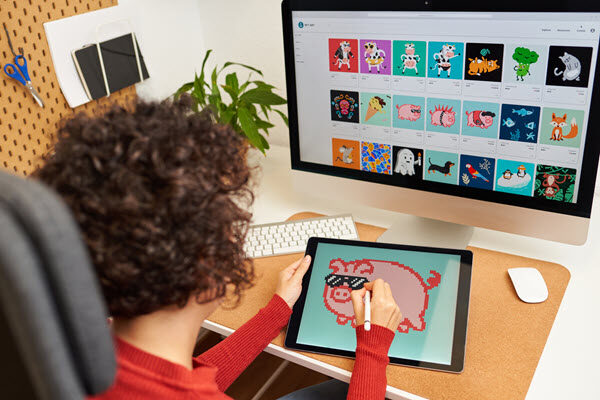It’s 2022, and it seems all the rage in media and digital asset news is surrounding non-fungible tokens (NFTs) and the Metaverse. NFTs have been around since at least 2017 when the OG CyberPunks launched. Yet, 2021 was the defining year that changed everything.
It was 2021 when digital artist Mike Winkelmann, aka Beeple, sold his NFT, “Everydays: The First 5,000 Days,” for $69 million at Christie’s auction house, and a shocked world took notice. And today, OpenSea, an NFT marketplace that launched in 2017 and completed a Series C funding round for $300 million in January 2022, is valued at $13.3 billion.
Let’s put that in context. That’s larger than Sprint, Alcoa, American Airlines, Whirlpool, Morningstar Financial, The New York Times, and a whole host of well-known global companies. Incredible, isn’t it?

What is an NFT anyway?
An NFT, or non-fungible token, is a unique, one-of-a-kind digital asset, quite the opposite of something fungible, which is like-for-like (i.e., the US dollar or Bitcoin). They have the following characteristics:
- Uniqueness, which establishes a value that potentially can increase over time
- They designate ownership (the digital wallet), rendering counterfeits nearly impossible on a decentralized system (blockchain) that contains permanent records
- They are indivisible and authentic
- They are transparent and have an audit trail (the block explorer)
- They are rare
NFTs, apart from buying, selling, and trading in the marketplace, can also bring tremendous value to those in the business world who seek opportunities. For example, let’s take a look at a marketing use case currently being employed by entrepreneur Mark Cuban, owner of the NBA Dallas Mavericks Basketball team.
Before each game, the Mavericks mint 20,000 NFTs, and each fan who attends in person (and it must be in person) and scans their game ticket during the first quarter receives one free NFT. At the end of the game, the club burns the unused NFTs, thereby making them rare and instantly codifying a small community of NFT owners who share a unique experience.
Let’s say one of the Maverick’s stars, Luka Dončić has an NBA record-breaking game. That immediately brings greater value to that NFT, and fans are allowed to sell them for profit should they appreciate in value. This use of NFTs has given the Mavericks understanding of the consumption behaviors of their fan base that they didn’t have prior to this NFT project. Listen to Mr. Cuban talk about it himself when he sat down with our Perficient team at about the 7:12 mark.
The Business Value of NFTs and Cases for Future Use
Backing an NFT with a smart contract can generate all sorts of business value. Let’s say an automotive manufacturer wanted to produce a line of NFTs based on early-stage renderings of iconic vehicles. Now, combine that image with a smart contract that might give the owner any number of things, from extended warranties, perks on accessories, and access to sponsored sporting events where they could meet the sponsored athlete — the sky is the limit. If that NFT was an upsell at the time of the vehicle purchase, it’s possible over time that the NFT could bring its owner greater value and could be a lucrative incentive when the owner decides to sell that vehicle. Additionally, with all the enhanced display screens in new cars today, it’s possible that NFT owners would want to “show off” their collection to their riders. As a sidebar, Samsung has just released a new feature in 2022 that allows users to browse and buy NFTs directly from their TV set and then display the collection to in-home guests. NFT owners are much like those who collect art; they love showing others what interests them. For the innovative business, it may just be a way to further promote the brand and build community.
Blockchain-based games are leveraging NFTs to bring financial gain to their owners and game developers alike. The phrase “Play to Earn” has now overtaken “Play to Win.” Selling NFT-based game assets (swords, magic wands, armor, a trusty steed, etc.) prior to the launch of a new game is a great way for game developers to raise capital prior to production. Having been pre-funded, once the game launches, gamers can use their pre-bought assets to win battles or challenges. Once several battles have been won, the lore of that asset appreciates, thereby making it more desirable. The owner at that point can trade it, loan it, sell or keep it.
But you get the concept; they make money. Game developers can raise funds rather than seek venture capital, and gamers can buy valuable assets that they own, not the game developer. Many of the assets can also be transferred from game to game if they are part of the Metaverse.
I’m guessing you’ve heard the term, Metaverse, lately. It brings me to my last point for this post.
The Metaverse is a growing digital counterpart to life in the real world. It’s connected games, it’s virtual reality, it’s augmented and mixed reality, it’s 3D, and it’s like Second Life reimagined with Web 3.0.
But how do NFT fit into any of this? Let’s look at Decentraland. Decentraland is a place where users can create, explore, and trade in the first-ever virtual world owned by its users. In it, you can own property, buy land, or trade just about anything. NFTs will be that mechanism that conveys ownership and value. As the popularity and audience levels grow, so too could digital asset portfolio values for those early adopters.
If Ray Kurzweil’s law of accelerating returns is true, 2022 and beyond will prove to be an exciting and explosive era in the world of digital assets and NFTs.
Will you help your company be part of that story?

